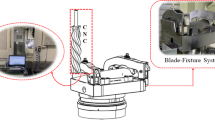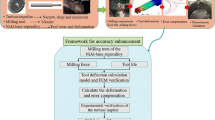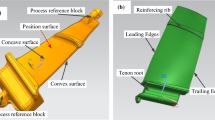Abstract
Fuel nozzle is a key part of aero-engines. Due to the particularity of fuel nozzle’s working environment, the high machining requirements for the surface quality and geometric accuracy of nozzle hole were put forward. The existing process is difficult to meet the machining requirements, so a new process is proposed, which is called the flexible single-pass honing. For the novel single-pass honing tool with diameter less than 1 mm, the laws are not very clear, so studies were carried out. Firstly, a novel cutting force model of single-pass honing was established, which explains the relationship between force and machining parameters. Based on the cutting force model, the influence laws of honing parameters on surface roughness, bore diameter, and shape accuracy were explored detailedly. Finally, according to the machining requirements of fuel nozzles, the honing process optimization was carried out, and the optimal parameters were obtained. Furthermore, precision control of surface quality and geometric accuracy for fuel nozzle single-pass honing was realized.























Similar content being viewed by others
Data availability
All data generated or analyzed during this study are included in the present article.
References
Liu YZ, Sun XX, Sethi V, Nalianda D, Li YG, Wang L (2017) Review of modern low emissions combustion technologies for aero gas turbine engines. Prog Aerosp Sci 94:12–45
Tamaki N, Nishikawa K (2015) Design of high-dispersion atomization nozzle for direct injection diesel engine (Effects of shapes and measurement of nozzle holes of injection nozzle on spray and flow characteristics). Transac Japan Soc Mech Eng 81(825):14–00228
Custer JR, Rizk NK (2011) Influence of design concept and liquid properties on fuel injector performance. J Propuls Power 4(4):378–384
BŠhre D, Schmitt C, Moos U (2012) Analysis of the differences between force control and feed control strategies during the honing of bores. Procedia CIRP 1:377–381
Joliet R, Kansteiner M, Kersting P (2015) A process model for force-controlled honing simulations. Procedia CIRP 28:45–51
Biermann D, Marschalkowski K, Paffrath K (2010) Development of a honing process for the combination machining of hardened axisymmetric parts. Prod Eng 4(2):147–155
Hoffmeister HW, Grosse T, Gerdes T (2012) Investigation of the influence of different process setting parameters on the surface formation at honing of thermally sprayed layers. Procedia CIRP 1:371–376
Zhang XP, Wang XQ, Wang DM, Wang XJ, Yao ZQ, Xi LF (2017) Methodology to improve the cylindricity of engine cylinder bore by honing. J Manuf Sci E-T ASME 139(3):1–10
Mansori ME, Goeldel B, Sabri L (2013) Performance impact of honing dynamics on surface finish of precoated cylinder bores. Surf Coat Technol 215:334–339
Lee J, Malkin S (1993) Experimental investigation of the bore honing process. J Eng Industry (4):115
Sabri L, Mezghani S, Mansori ME (2010) A study on the influence of bond material on honing engine cylinder bores with coated diamond stones. Surf Coat Technol 205(5):1515–1519
Cabanettes F, Dimkovski Z, Rosén BG (2015) Roughness variations in cylinder liners induced by honing tools’ wear. Precis Eng 41:40–46
Sabri L, Mansori ME (2009) Process variability in honing of cylinder liner with vitrified bonded diamond tools. Surf Coat Technol 204(6-7):1046–1050
Gouskov AM, Voronov SA, Butcher EA, Sinha SC (2006) Non-conservative oscillations of a tool for deep hole honing. Commun Nonlinear Sci Numer Simul 11(6):685–708
Moos U, Bähre D (2015) Analysis of process forces for the precision honing of small bores. Procedia CIRP 31:387–392
Klocke F, Kuchle A (2009) Manufacturing processes 2: grinding, honing, lapping
Yousfi M, Demirci I, Mezghani S, EI Mansori M. (2015) Smoothness and plateauness contributions to the running-in friction and wear of stratified helical slide and plateau honed cylinder liners. Wear 332-333:1238–1247
Yousfi M, Mezghani S, Demirci I, EI Mansori M. (2014) Mutual effect of groove size and anisotropy of cylinder liner honed textures on engine performances. Adv Mater Res 966-967:175–183
Arunachalam S, Gunasekaran A, O'Sullivan JM (1999) Analysing the process behaviour of abrasive reaming using an experimental approach. Int J Mach Tool Manu 39(8):1311–1325
Lu YJ, Li J, Liang RD, Zhang YF, Luo MM, Guo C (2020) Investigation on the effect of honing parameters on cylindricity of engine cylinder liner. Int J Adv Manuf Technol 111(11-12):1–12
Yang XR, Zhu YW, Qi X, Xu ZX (2013) Optimization of the reaming honing process of valve sleeve based on orthogonal test. Diamond Abrasive Eng 33:26–30 (In Chinese)
Kholmogortsev YP (2009) Optimizing the diamond reaming of precision holes. Russ Eng Res 29(4):375–382
Yang CY, Su H, Gao SW, Ai QF, Xu JH (2020) Characterization and life prediction of single-pass honing tool for fuel injection nozzle. Chin J Aeronaut 34(4):225–240
Gao SW, Yang CY, Xu JH, Fu YC, Su H, Ding WF (2017) Optimization for internal traverse grinding of valves based on wheel deflection. Int J Adv Manuf Technol 92(1-4):1105–1112
Cao JG, Wu YB, Li JY, Zhang QJ (2015) A grinding force model for ultrasonic assisted internal grinding (UAIG) of SiC ceramics. Int J Adv Manuf Technol 81(5-8):875–885
Yang M, Li CH, Zhang YB, Jia DZ, Li RZ, Hou YL, Cao HJ (2019) Effect of friction coefficient on chip thickness models in ductile-regime grinding of zirconia ceramics. Int J Adv Manuf Technol 102(5-8):2617–2632
Ren JX, Hua DA, Zhou WY (2011) Grinding Theory. Electronic Industry Press (In Chinese) 37–38
Gao SW, Yang CY, Xu JH, Su H, Fu YC (2018) Modelling and simulation of bore diameter evolution in finish honing. Procedia Manuf 26:462–468
Funding
This work was funded by the National Natural Science Foundation of China (No. 52075252).
Author information
Authors and Affiliations
Contributions
Changyong Yang conceived the analysis and wrote the manuscript. Hao Su and Shaowu Gao performed the experiment and collected the data. Yucan Fu provided supervision on experiment. Wenfeng Ding and Jiuhua Xu revised the manuscript.
Corresponding author
Ethics declarations
Ethics approval and consent to participate
The article follows the guidelines of the Committee on Publication Ethics (COPE) and involves no studies on human or animal subjects.
Consent for publication
Not applicable.
Competing interests
The authors declare no competing interests.
Additional information
Publisher’s note
Springer Nature remains neutral with regard to jurisdictional claims in published maps and institutional affiliations.
Rights and permissions
About this article
Cite this article
Yang, C., Su, H., Gao, S. et al. Surface quality and geometric accuracy control of fuel nozzle single-pass honing. Int J Adv Manuf Technol 114, 3325–3336 (2021). https://doi.org/10.1007/s00170-021-07103-5
Received:
Accepted:
Published:
Issue Date:
DOI: https://doi.org/10.1007/s00170-021-07103-5




